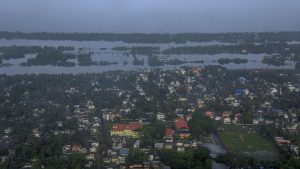Martin Luther King Jr once spoke of building “dykes of courage”, a memorable sermon about forcing change on America’s entrenched racially segregated system. But after the worst floods in the southern Indian state of Kerala in nearly a century, the issue is not about forcing change but dealing with it.
From India’s most urbanised state, with an enviable record of social, health and educational progress over many decades, Kerala now confronts a truly dreadful prospect of hardship, human suffering, loss, immense need and finite resources for at least the next few years.
The damage is extensive and that is even before the floodwaters have started to recede, the likely consequences of waterborne disease are factored in and a proper tally drawn up. Nearly two weeks of an unusually heavy monsoon have left tens of thousands of homes, 200 bridges and 6,000 miles of roads, including major highways, destroyed or badly damaged. More than 350 people have died. Some 725,000 are homeless and in 5,645 relief camps, hastily set up in schools, colleges, community centres or anywhere that seems safe.
The Malayali diaspora, watching in agony from around the world, has been working overtime to keep Kerala’s tragedy at the top of social media feeds. They have been doing a good job — often a necessary humanitarian one — pointing out from afar isolated communities in need of rescue from the rising waters, complete with GPS coordinates. The diaspora has also been mobilising aid and other resources. Indians at home and elsewhere have gratefully noted that humanity overrides politics and geographical divisions, with the Pakistan Association Dubai among those sending relief supplies.
So far, the publicity has been paying off and most people in Kerala don’t seem to feel forgotten. India’s federal government has sent in the military to save lives. Other Indian states have offered assistance — money, food and 100 doctors and paramedics from Maharashtra, for instance. In the dark humour of a cartoon in an Indian newspaper, two Malayali men atop a roof, with the waters rising all around, comfort each other with the words: “Good news is that the entire country is united in helping us.”
That is all fine up to a point but public attention is fickle, lasting only as long as it takes for the news cycle to move on. In the circumstances, Kerala’s chief resource in dealing with an outlier like the floods of 2018 has to be resilience. These floods will probably end up doing more economic damage and taking a greater toll in terms of human suffering than anything else in Kerala since the great deluge of 1924.
As insurance companies around the world have acknowledged in the past few years, the cost of natural disasters is rising but in terms of money rather than lives. This is mostly because our more technologically advanced, better-informed world has succeeded in making natural disasters less deadly. But more of the world’s population and economic activity is concentrated in places where disasters are likely. Kerala fits the bill. It is crisscrossed by 44 rivers and beset by illegal sand mining from those rivers in order to feed India’s appetite for a billion square yards a year of mostly concrete property development. Despite warnings in 2011, environmentally dangerous economic activity has also been allowed in parts of Kerala.
In any case, it is inevitable that the economic cost of these floods will be higher than in 1924. For a start, the state is more urbanised than the erstwhile Malabar, Travancore-Cochin, Kasargod and South Kanara, that merged to form Kerala in 1956. It also has a higher population.
The way forward clearly has to be recognition of the cost of rare, unpredictable events such as floods and for better development to mitigate their possible consequences. This might mean more stringent government action than before against sand-mining, ecologically harmful industrial activity and new building codes to make urban Kerala more resilient to floodwaters.
But perhaps it also calls for something else. For Kerala in particular, and India more generally, this disaster offers an opportunity to assess change-readiness. The concept was pioneered by consulting firm KPMG after Haiti’s devastating 2010 earthquake. As KPMG’s global chair of international development assistance services Timothy Stiles put it at the time: “There was a thought that, regardless of the amount of development money being poured into Haiti, they wouldn’t be able to use it as effectively as other nations might. We couldn’t put our finger on exactly why but that was the general sense from the people who had worked there.”
So KPMG created the global change readiness index to measure a country’s ability to adapt rapidly in response to disaster or opportunity. Until 2017, when Switzerland came out top, Singapore led the pack. Indeed, change-readiness must be in a country — and a people’s — cultural DNA if it is to adapt in response to good things and bad. The dykes Kerala needs are not physical constructs.


